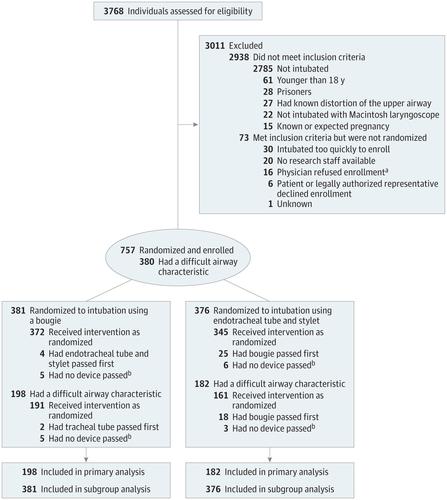Our official English website, www.x-mol.net, welcomes your
feedback! (Note: you will need to create a separate account there.)
Effect of Use of a Bougie vs Endotracheal Tube and Stylet on First-Attempt Intubation Success Among Patients With Difficult Airways Undergoing Emergency Intubation
JAMA ( IF 63.1 ) Pub Date : 2018-06-05 , DOI: 10.1001/jama.2018.6496 Brian E. Driver 1 , Matthew E. Prekker 1, 2 , Lauren R. Klein 1 , Robert F. Reardon 1 , James R. Miner 1 , Erik T. Fagerstrom 1 , Mitchell R. Cleghorn 3 , John W. McGill 1 , Jon B. Cole 1
JAMA ( IF 63.1 ) Pub Date : 2018-06-05 , DOI: 10.1001/jama.2018.6496 Brian E. Driver 1 , Matthew E. Prekker 1, 2 , Lauren R. Klein 1 , Robert F. Reardon 1 , James R. Miner 1 , Erik T. Fagerstrom 1 , Mitchell R. Cleghorn 3 , John W. McGill 1 , Jon B. Cole 1
Affiliation

|
Importance The tracheal tube introducer, known as the bougie, is typically used to aid tracheal intubation in poor laryngoscopic views or after intubation attempts fail. The effect of routine bougie use on first-attempt intubation success is unclear. Objective To compare first attempt intubation success facilitated by the bougie vs the endotracheal tube + stylet. Design, Setting, and Patients The Bougie Use in Emergency Airway Management (BEAM) trial was a randomized clinical trial conducted from September 2016 through August 2017 in the emergency department at Hennepin County Medical Center, an urban, academic department in Minneapolis, Minnesota, where emergency physicians perform all endotracheal intubations. Included patients were 18 years and older who were consecutively admitted to the emergency department and underwent emergency orotracheal intubation with a Macintosh laryngoscope blade for respiratory arrest, difficulty breathing, or airway protection. Interventions Patients were randomly assigned to undergo the initial intubation attempt facilitated by bougie (n = 381) or endotracheal tube + stylet (n = 376). Main Outcomes and Measures The primary outcome was first-attempt intubation success in patients with at least 1 difficult airway characteristic (body fluids obscuring the laryngeal view, airway obstruction or edema, obesity, short neck, small mandible, large tongue, facial trauma, or the need for cervical spine immobilization). Secondary outcomes were first-attempt success in all patients, first-attempt intubation success without hypoxemia, first-attempt duration, esophageal intubation, and hypoxemia. Results Among 757 patients who were randomized (mean age, 46 years; women, 230 [30%]), 757 patients (100%) completed the trial. Among the 380 patients with at least 1 difficult airway characteristic, first-attempt intubation success was higher in the bougie group (96%) than in the endotracheal tube + stylet group (82%) (absolute between-group difference, 14% [95% CI, 8% to 20%]). Among all patients, first-attempt intubation success in the bougie group (98%) was higher than the endotracheal tube + stylet group (87%) (absolute difference, 11% [95% CI, 7% to 14%]). The median duration of the first intubation attempt (38 seconds vs 36 seconds) and the incidence of hypoxemia (13% vs 14%) did not differ significantly between the bougie and endotracheal tube + stylet groups. Conclusions and Relevance In this emergency department, use of a bougie compared with an endotracheal tube + stylet resulted in significantly higher first-attempt intubation success among patients undergoing emergency endotracheal intubation. However, these findings should be considered provisional until the generalizability is assessed in other institutions and settings. Trial Registration clinicaltrials.gov Identifier: NCT02902146
中文翻译:

使用探条与气管内导管和管心针对困难气道急诊插管患者首次尝试插管成功率的影响
重要性 气管导管导引器,称为探条,通常用于在喉镜视野不佳或气管插管失败后辅助气管插管。常规探条使用对首次尝试插管成功的影响尚不清楚。目的 比较探条与气管插管 + 管心针促进的首次尝试插管成功率。设计、设置和患者 紧急气道管理 (BEAM) 中使用 Bougie 试验是一项随机临床试验,于 2016 年 9 月至 2017 年 8 月在明尼苏达州明尼阿波利斯市的城市学术部门亨内平县医疗中心的急诊科进行,其中急诊医师执行所有气管插管。纳入的患者为 18 岁及以上,他们连续进入急诊科并接受了使用 Macintosh 喉镜刀片进行紧急经口气管插管以治疗呼吸停止、呼吸困难或气道保护。干预 患者被随机分配接受由探条 (n = 381) 或气管插管 + 管心针 (n = 376) 促进的初始插管尝试。主要结果和措施 主要结果是至少有 1 种困难气道特征(体液遮挡喉部视野、气道阻塞或水肿、肥胖、短颈、小下颌骨、大舌头、面部创伤或颈椎固定的需要)。次要结局是所有患者的首次尝试成功,首次尝试插管成功且无低氧血症,首次尝试时间、食管插管和低氧血症。结果 在随机分组的 757 名患者(平均年龄 46 岁;女性,230 [30%])中,757 名患者 (100%) 完成了试验。在至少具有 1 个困难气道特征的 380 名患者中,探条组的首次尝试插管成功率 (96%) 高于气管插管 + 管心针组 (82%)(绝对组间差异,14% [95] % CI,8% 至 20%])。在所有患者中,探条组的首次尝试插管成功率 (98%) 高于气管插管 + 管心针组 (87%)(绝对差异,11% [95% CI,7% 至 14%])。第一次插管尝试的中位持续时间(38 秒对 36 秒)和低氧血症的发生率(13% 对 14%)在探条组和气管插管 + 管心针组之间没有显着差异。结论和相关性 在该急诊科,与气管插管 + 管心针相比,使用探条在接受紧急气管插管的患者中显着提高了首次尝试插管的成功率。然而,在其他机构和环境中评估普遍性之前,这些发现应被视为临时性的。试验注册clinicaltrials.gov 标识符:NCT02902146
更新日期:2018-06-05
中文翻译:

使用探条与气管内导管和管心针对困难气道急诊插管患者首次尝试插管成功率的影响
重要性 气管导管导引器,称为探条,通常用于在喉镜视野不佳或气管插管失败后辅助气管插管。常规探条使用对首次尝试插管成功的影响尚不清楚。目的 比较探条与气管插管 + 管心针促进的首次尝试插管成功率。设计、设置和患者 紧急气道管理 (BEAM) 中使用 Bougie 试验是一项随机临床试验,于 2016 年 9 月至 2017 年 8 月在明尼苏达州明尼阿波利斯市的城市学术部门亨内平县医疗中心的急诊科进行,其中急诊医师执行所有气管插管。纳入的患者为 18 岁及以上,他们连续进入急诊科并接受了使用 Macintosh 喉镜刀片进行紧急经口气管插管以治疗呼吸停止、呼吸困难或气道保护。干预 患者被随机分配接受由探条 (n = 381) 或气管插管 + 管心针 (n = 376) 促进的初始插管尝试。主要结果和措施 主要结果是至少有 1 种困难气道特征(体液遮挡喉部视野、气道阻塞或水肿、肥胖、短颈、小下颌骨、大舌头、面部创伤或颈椎固定的需要)。次要结局是所有患者的首次尝试成功,首次尝试插管成功且无低氧血症,首次尝试时间、食管插管和低氧血症。结果 在随机分组的 757 名患者(平均年龄 46 岁;女性,230 [30%])中,757 名患者 (100%) 完成了试验。在至少具有 1 个困难气道特征的 380 名患者中,探条组的首次尝试插管成功率 (96%) 高于气管插管 + 管心针组 (82%)(绝对组间差异,14% [95] % CI,8% 至 20%])。在所有患者中,探条组的首次尝试插管成功率 (98%) 高于气管插管 + 管心针组 (87%)(绝对差异,11% [95% CI,7% 至 14%])。第一次插管尝试的中位持续时间(38 秒对 36 秒)和低氧血症的发生率(13% 对 14%)在探条组和气管插管 + 管心针组之间没有显着差异。结论和相关性 在该急诊科,与气管插管 + 管心针相比,使用探条在接受紧急气管插管的患者中显着提高了首次尝试插管的成功率。然而,在其他机构和环境中评估普遍性之前,这些发现应被视为临时性的。试验注册clinicaltrials.gov 标识符:NCT02902146















































 京公网安备 11010802027423号
京公网安备 11010802027423号